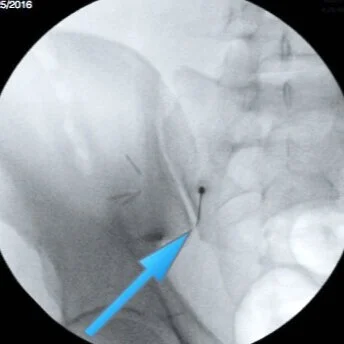
Sacroiliac Joint Injection
How do you diagnose Sacroiliac Joint disease?
Definitively diagnosing Sacroiliac Joint disease is difficult. Both physical examination findings and pain symptoms are similar to many other diseases that cause low back pain. Imaging studies such as Computed Tomography (CT Scan) or Magnetic Resonance Imaging (MRI) can also be non-specific. The gold-standard for diagnosing and potentially treating Sacroiliac Joint disease is Sacroiliac Joint Injection.
What is Sacroiliac Joint Injection?
For Sacroiliac Joint Injection, a combination of local anesthetic and steroid is injected into the Sacroiliac Joint. The injection is performed either in a doctor's office or a surgical center on an out-patient basis.The patient is asked to lie face-down on the table. A cleaning solution is applied to area of needle insertion. Sacroiliac Joint is visualized with an x-ray machine. A needle is inserted into the joint and a small amount of dye is injected into the joint to confirm position of the needle.
This is followed by an injection of a local anesthetic and steroid into the Sacroiliac Joint. If patients get no relief from Sacroiliac Joint injection, then they are unlikely to be suffering from Sacroiliac joint disease.
Can you help if pain relief from Sacroiliac Joint Injection lasts for a short duration?
In some patients, pain relief from Sacroiliac Joint Injection only lasts for a short duration. In these patients, Sacroiliac Joint Injection can be repeated or Radiofrequency Ablation can be performed.
What is a Radiofrequency Ablation (RFA) of the Sacroiliac Joint?
Radio frequency Ablation has become the treatment of choice for patients in whom Sacroiliac Joint Injection fails to provide long-term pain relief. Radiofrequency ablation is a procedure in which radiofrequency waves are used to produce heat on specifically identified nerves. By generating heat around the nerves that supply the Sacroiliac Joint, the ability of the nerves to transmit pain signals to the brain is destroyed, thus ablating the nerve.
What are the risk and complications of Sacroiliac Joint Injection or RFA?
It is generally a safe procedure. But as with any interventional procedure, it carries a small risk of potential complications such as bleeding, infection, leaking spinal fluid and injury to blood vessels or nerves around the spine.
What are the common cause of back pain?
Common causes of back pain include:
Spinal Canal narrowing


